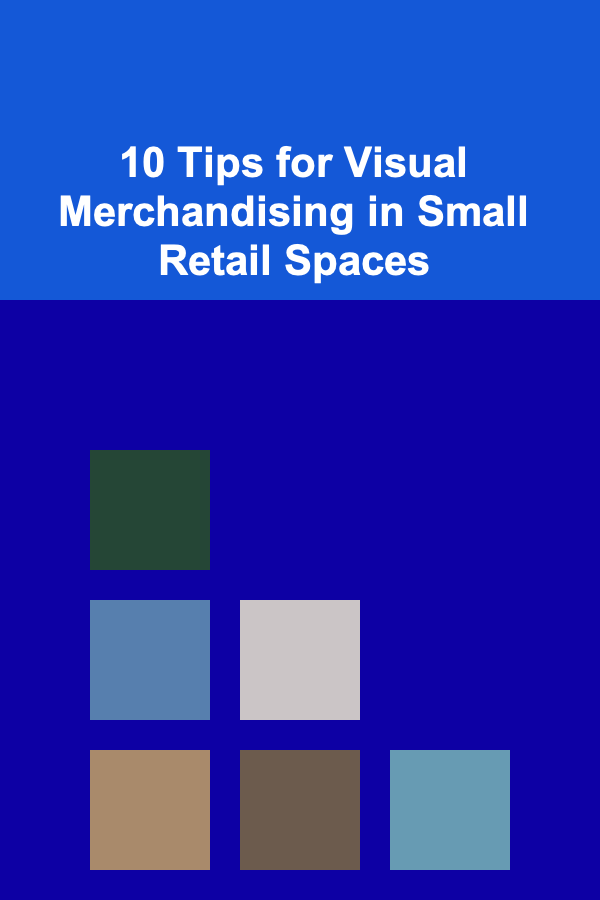
10 Tips for Visual Merchandising in Small Retail Spaces
ebook include PDF & Audio bundle (Micro Guide)
$12.99$10.99
Limited Time Offer! Order within the next:

Visual merchandising is one of the most important aspects of retail strategy, particularly for small retail spaces. In a world where consumers are constantly bombarded with choices, it is crucial for retailers to create an environment that captures attention, sparks interest, and leads to purchases. For small retail spaces, every square foot matters, and the way products are displayed can significantly influence sales and customer perception. This article will explore 10 tips for optimizing visual merchandising in small retail environments.
Maximize the Use of Vertical Space
In small retail spaces, floor space is limited, but vertical space often remains underutilized. To make the most of the available area, you should focus on displaying products at varying heights to draw the eye upward.
How to Use Vertical Space:
- Wall Shelving: Install shelves on walls to display products without taking up floor space. Floating shelves or sleek vertical racks can create the illusion of more space while maximizing storage.
- Pegboards and Hooks: These versatile tools allow you to hang products such as accessories, bags, or clothing. They can be arranged in a way that creates an organized, clutter-free environment.
- Tall Displays: Use tall mannequins, product stands, or display units to create a sense of height and draw customers' attention upward.
Maximizing vertical space not only increases storage but also makes the store feel larger and more open.
Create Focal Points
In small spaces, creating strong focal points is essential for guiding customer attention and enhancing the shopping experience. Focal points highlight featured items, seasonal promotions, or best-sellers.
How to Create Focal Points:
- Feature Displays: Set up dedicated areas for high-demand items, using different levels and props to create a visual hierarchy. For instance, placing a statement product at eye level on a pedestal can naturally attract attention.
- Lighting: Lighting plays a crucial role in creating focal points. Use spotlights or track lighting to highlight key items, creating contrast against the rest of the store.
- Color Contrast: Select items with contrasting colors for a dynamic display. A bold, colorful product in a neutral-toned store can act as a visual anchor.
Focal points help customers navigate the space and make decisions quickly, boosting the likelihood of purchase.
Utilize Mirrors to Expand Space
Mirrors are a powerful tool in small retail spaces because they visually expand the area and reflect light. The strategic use of mirrors can create a sense of depth and make the space feel more open and inviting.
How to Use Mirrors:
- Reflect Key Displays: Place mirrors strategically so they reflect featured displays or focal points, helping to double the visual impact.
- Wall Mirrors: Full-length mirrors work well in apparel stores, encouraging customers to interact with the display and visualize the product on themselves.
- Mirrored Furniture or Fixtures: Use display units or tables with mirrored surfaces to create a sense of luxury and openness.
Mirrors are an inexpensive yet effective way to enhance both the aesthetics and functionality of your retail space.
Create a Flow with Clear Pathways
In a small retail space, it's essential to guide customers through the store in a way that encourages browsing without overcrowding. Clear pathways create a natural flow, allowing customers to explore products in a logical manner.
How to Create Flow:
- Wide Aisles: Ensure that aisles are wide enough for customers to move freely. A cramped store can feel claustrophobic and discourage people from staying long.
- Display Zones: Divide the store into distinct zones, such as a "new arrivals" section or a "sale" area, to guide customers through various types of products.
- Open Display Fixtures: Avoid overcrowding the floor with large fixtures. Use open shelving or racks that don't block sightlines and make the space feel more expansive.
A well-organized flow encourages longer visits and increases the chances of customers discovering additional products.
Use Signage Wisely
Signage is essential in any retail environment, but in a small space, less is often more. Over-cluttered signage can detract from the shopping experience. Instead, aim for clear, concise, and effective messaging.
How to Use Signage:
- Branding and Messaging: Use simple, bold signage to communicate your brand's identity and promotions. A single, impactful sign that emphasizes sales or limited-time offers can capture attention quickly.
- Directional Signs: In tight spaces, use small directional signs or arrows to guide customers to specific product areas or new collections.
- Price Tags and Labels: Ensure that price tags are easy to read and positioned clearly on the products. Avoid hiding prices in inaccessible spots.
Effective signage provides key information quickly without overwhelming the customer, helping to guide their purchase decisions.
Incorporate Creative Displays
Creative displays can set your store apart from others and enhance the shopping experience. In small spaces, it's crucial to be inventive with how products are showcased to maintain the customer's interest.
How to Create Creative Displays:
- Themed Displays: Use a theme to display products that might otherwise feel disconnected. For example, create a summer vibe with beach accessories, or an urban style theme with streetwear.
- Props and Fixtures: Use props such as plants, mannequins, or unique furniture to add personality and creativity to the store. For example, a vintage suitcase can serve as a display for leather goods, while a rustic chair can showcase scarves or hats.
- Interactive Displays: Let customers touch, feel, and try on products. For instance, allow customers to interact with an iPad for an electronic demo or have a tactile display for soft fabrics.
Creative displays not only captivate but also encourage customers to engage with your products and spend more time in the store.
Focus on Product Groupings
In small retail spaces, grouping similar products together can help to organize the store and make it easier for customers to find what they're looking for. Grouping products based on category, color, or style can create visual interest and facilitate decision-making.
How to Create Product Groupings:
- By Category: Display products in related categories, such as "casual wear" next to "accessories" or "kitchen gadgets" next to "baking supplies."
- By Color Scheme: Create color-coordinated product displays to appeal to customers' aesthetic preferences. For example, placing all blue items together can create a calm, cohesive effect.
- Seasonal Grouping: Showcase seasonal items together, like holiday decorations or summer essentials, to create a sense of relevance and urgency.
Grouping products strategically reduces decision fatigue, making it easier for customers to make choices and purchase.
Create a Sense of Storytelling
A small retail space offers a unique opportunity to tell a story through your displays. Customers are more likely to connect emotionally with a store that feels immersive and meaningful.
How to Tell a Story:
- Thematic Displays: Curate your products to tell a narrative. For instance, create a cozy winter atmosphere with scarves, mittens, hot cocoa mugs, and blankets, implying that "winter nights" are your theme.
- Product Origins: Tell the story behind your products, such as their artisan craftsmanship, local sourcing, or sustainability efforts. Use small signage or video screens to share these stories.
- Lifestyle Depictions: Instead of just displaying products, show how they fit into customers' lives. For example, set up a "bedroom" corner featuring bedding, pillows, and books to create a relaxing environment.
Storytelling adds an emotional layer to the shopping experience and helps build brand loyalty.
Focus on Lighting
Lighting is one of the most powerful tools in visual merchandising. Proper lighting can transform a small retail space, creating a welcoming and comfortable environment while highlighting key products.
How to Use Lighting:
- Layered Lighting: Use a combination of ambient, task, and accent lighting to create a balanced and welcoming environment. Ceiling lights provide general lighting, while spotlights can focus on specific displays.
- Natural Light: If possible, take advantage of natural light. It adds warmth and freshness to a store, making it more inviting. Consider using sheer curtains or window displays that allow sunlight to filter through.
- LED Lights: Energy-efficient LED lighting can be used to spotlight products while keeping energy costs low. LED strips can also be placed along shelves or fixtures to highlight product features.
Proper lighting not only enhances the ambiance but also helps customers focus on the items you want them to see.
Maintain Cleanliness and Organization
Finally, in small spaces, cleanliness and organization are crucial. A cluttered or dirty store can drive customers away and negatively impact your brand's reputation.
How to Maintain Cleanliness and Organization:
- Regular Cleaning: Ensure that surfaces are wiped down, products are dust-free, and the store remains tidy throughout the day. Pay attention to high-traffic areas like entryways and shelves.
- Organized Stockroom: Keep a well-organized stockroom to make it easier to replenish items on the floor. An efficient stockroom ensures that displays are always full and well-maintained.
- Orderly Product Display: Avoid overcrowding displays or leaving products in disarray. A neatly arranged product grouping is more visually appealing and encourages customers to browse.
A clean and organized store makes the shopping experience more enjoyable and comfortable for customers.
Conclusion
Visual merchandising is an essential element in creating a successful retail space, especially for small stores. By utilizing these 10 tips---maximizing vertical space, creating focal points, incorporating creative displays, and ensuring proper lighting---you can transform a small space into a visually appealing and efficient retail environment. A well-merchandised store engages customers, enhances their shopping experience, and ultimately drives sales.
Reading More From Our Other Websites
- [Home Pet Care 101] How to Train a Dog to Use a Leash: Essential Tips for New Pet Owners
- [Weaving Tip 101] From Loom to Living Room: Transform Your Space with Hand-Woven Wall Hangings
- [Home Pet Care 101] How to Create a Pet-Friendly Cleaning Routine That's Safe and Effective
- [Organization Tip 101] The Ultimate Guide to Basement Waterproofing: Tips and Solutions
- [Organization Tip 101] Why You Should Utilize Wall Space for Better Organization
- [Stamp Making Tip 101] From Quill to Rubber: A Step-by-Step Guide to Creating Custom Calligraphy Stamps
- [Home Storage Solution 101] How to Organize Your Pantry with Easy and Affordable Solutions
- [Home Renovating 101] How to Design Your Dream Home During a Renovation
- [Home Holiday Decoration 101] How to Incorporate Vintage Holiday Decor into Modern Spaces
- [Personal Care Tips 101] How to Choose Lip Balm for a Soft, Plump Look

How to Handle Conference Logistics: A Comprehensive Checklist
Read More
How to Maintain Healthy Bees and Prevent Common Problems
Read More
How to Maximize Small Bedroom Space with Smart Furniture Choices
Read More
Why Organizing Your Outdoor Space Can Enhance Entertaining
Read More
10 Tips for Managing Project To-Do Lists with Remote Teams
Read More
How to Wrap Gifts Like a Pro: A Comprehensive Checklist
Read MoreOther Products

How to Handle Conference Logistics: A Comprehensive Checklist
Read More
How to Maintain Healthy Bees and Prevent Common Problems
Read More
How to Maximize Small Bedroom Space with Smart Furniture Choices
Read More
Why Organizing Your Outdoor Space Can Enhance Entertaining
Read More
10 Tips for Managing Project To-Do Lists with Remote Teams
Read More